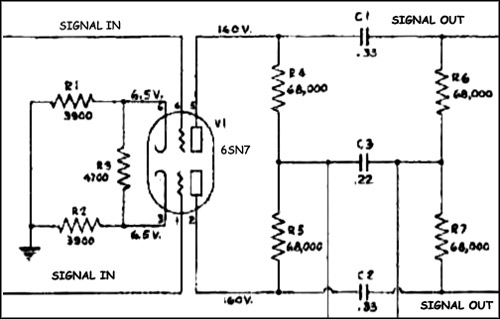The HAMMOND ORGAN
North Suburban HAMMOND ORGAN Service
The last item that we will look at regarding a typical Hammond Organ is the power amplifier. Here, the signal from the console gets increased in power enough to drive the loudspeakers. Hammond power amplifiers are fairly standard, very conservatively rated, and of the typical excellent, rugged Hammond construction. The earliest power amplifiers used standard power triode tubes of the 1930s, type 2A3. Later models used more modern tubes 6V6 or 6L6 with additional grids and called called power pentodes, and the more recent power amplifiers used transistors instead of tubes.
One of the on-going arguments as regards power amplifiers for musical instruments concerns the relative merits of tubes vs. transistors. Some folks state that there is a certain "warmth" [whatever exactly such a subjective description means] regarding the sound of a musical instrument whose speakers are driven by a tube type amplifier as opposed to the sound of an instrument that is heard through a solid-state or transistorized amplifier.

Figure 31, the input stage of an early Hammond power amplifier. The balanced signal comes in on the left and each side goes to one grid in the tube V1. There is 160 volts DC on the plates of the tube and the amplified signal on the plates then passes through capacitors C1 and C2 to the next section of the power amplifier. The cathodes of the input tube are grounded through the 3900 ohm resistors, and the current flowing through to the plates causes the 6.5 volts to appear on the cathodes. In many of the early Hammond power amplifiers, the speaker field coils were also doing double duty as filter chokes for the power supply.
Since I occasionally insert my "two-cents' worth" here and there, in my opinion, if there is any difference at all, it is extremely subtle. I could not, if I didn't see ahead of time what type of amplifier was in use, be able to tell the difference. The claim for the merit of tube type power amplifiers is that if there is any distortion, it artificially generates the second (and other even numbered] harmonics, whereas distortion in solid state amplification circuitry generates odd numbered harmonics. In either case, distortion is distortion and one of the objects of all good amplifier designs is to eliminate all distortion as much as possible. So the moral of this dissertation, if indeed it has any moral at all, is that good amplifier design is more important than the means of operation. There is no question that solid state power amplifiers run cooler and consume less power than tube type amplifiers. Regardless of amplifier type, all amplifiers for Hammond organs do the following: accept the signal from the console, increase its level in an input stage, and finally increase the power level to that required to power the speakers.
One more consideration, before we look at a few specific Hammond power amplifiers is that of the power rating. Hammond speaker cabinets usually had a model designation that consisted of one or more letters followed by a number such as B40, HR40, A20, etc. The first letter was a model or style designation. The second letter, if present was an R which indicated that there was an artificial reverberation device in the speaker cabinet, and then the number was the amplifier power output in RMS watts.
Speaker and amplifier wattage ratings that you find on some audio equipment can be very misleading. Often some manufacturers will state a number which is relatively high and/or relatively meaningless. There is only one power rating which an audio engineer or a purchaser of audio equipment really needs to be concerned with and that is the RMS rating. The letters stand for Root Mean Square. Without repeating the calculus definition of this and how it is figured, which you can find by doing a Google search, let's just say that RMS power is the actual, true amount of electrical power that is being delivered. So if an amplifier is rated at 40 watts RMS, then that means that at its maximum level, it will send 40 watts of electrical power into the speakers that it is powering. Any other ratings, such as "peak" power, "music" power, or other terms are for all practical purposes meaningless. If I were to say that a Hammond amplifier can deliver 113.12 watts peak-to-peak, I'd be telling you the truth but it could be very misleading. Peak power, or peak-to-peak power or any other such ratings that some manufacturers say about their audio equipment imply more power than what is really there.
When Hammond says that the two power amplifiers in a B40 tone cabinet each deliver 20 watts of power, they actually do deliver 20 watts to each of the two pairs of 12" speakers in the cabinet, and if you've ever heard a B40 tone cabinet up close, you'll quickly realize that 40 true RMS watts of power into speakers will produce some serious volume, a lot more than you'd want to have in your living room.
Hammond power amplifiers take a balanced input signal from the console, and develop a suitable output to drive the speakers. A balanced output is one where there are two signal wires coming from an output transformer whose secondary winding has a grounded center tap. Schematically it looks like that of figure twenty-four on page thirteen.
When set up this way, any outside interference, such as stray 60 Hz power hum gets induced into both of the two signal wires. Since the signal phase in each is 180 degrees out of phase, it is neutralized and grounded out at the matching transformer, and as such has no influence. Here are two looks at an early Hammond power amplifier.
Previous page Page 19. Next page